Kellie Pearl - Kelly Pearl
Open FREE Unlimited Store Join Our Newsletter
Origin of Name
The Kellie/Kelly Pearl the largest freshwater pearl ever discovered in the 2,000-year history of the Scottish pearl industry, was found in 1621 in a tributary of the river Ythan in Aberdeen shire, and was later presented to King James VI, who got the rare jewel incorporated in the Scottish Crown, together with other pearls, rubies, diamonds and amethysts already on the crown. The crown was subsequently used for the coronation of Charles I in 1633 and Charles II in 1651. In 1707 after the Act of Union, the Kingdom of Scotland and the Kingdom of England were unified to form the Kingdom of Great Britain. The Scottish Crown Jewels also known as the "Honors of Scotland," which included the Crown, the Scepter and the Sword, now became redundant, and were locked up in a chest in Edinburgh Castle and forgotten for over a hundred years, until rediscovered in 1818 by a group of people led by Sir Walter Scott. It is not known exactly why the pearl was christened as Kellie/Kelly Pearl, but in all probability the name must have originated from the founder of the pearl, in accordance with established practice of naming famous pearls after their founders. The name Kellie/Kelly also refers to a clan name in Scotland, and the name of a Barony in Fife, Scotland, from which the title of Earl of Kellie/Kelly, a peerage title in the Peerage of Scotland, was created in 1619, for Sir Thomas Erskine, who was Captain of the Guard for James VI & I. It is not known whether there is any relationship between these names and the name of the pearl.

Crown of Scotland
Characteristics of the pearl
The Kellie/Kelly Pearl is said to be the largest freshwater pearl ever discovered not only in Scotland but the entire United Kingdom. However besides this significant fact, unfortunately none of the other characteristics of the pearl, such as its size, color, shape, luster, surface quality and nacre quality are not known. Out of the three basic shapes found in pearls, spherical, symmetrical and irregular (baroque), the common shape we come across in freshwater pearls is baroque, followed by symmetrical. Spherical and near spherical shapes among freshwater pearls is an extreme rarity. One such natural spherical pearl discovered from the freshwater mussel, Margaritifera margaritifera in Scotland in 1967, is the famous 44-grain Abernethy Pearl, which is now displayed in a glass covered case at Cairncross Jewelers, in Perth, Scotland. It is not known whether the Kellie/Kelly Pearl is also a spherical pearl, but given the fact that it was incorporated on the Scottish Royal Crown suggests that the pearl must be necessarily spherical or symmetrical to match with the Scottish pearls already on the crown. A baroque pearl having an irregular shape would have presented considerable difficulties for the designers of the crown, in finding a suitable place on the crown, without compromising its symmetry.
As far as the color of the pearl is concerned, it is well known that the most common color that occurs among freshwater pearls formed in Margaritifera margaritifera, is white, the predominant color of the nacre of this freshwater mussel. Other colors that are occasionally found are cream, yellow and pink. The Scottish Crown refashioned from an older crown in 1540, by the Royal Goldsmith John Mosman, for James V, was incorporated with 42 gemstones, and Scottish freshwater pearls taken from the older crown. Most of these freshwater pearls undoubtedly would have been white given the fact that white is the commonest color found among these pearls, which also enables the designer more freedom of choice in picking out matching pairs of pearls, to be placed in symmetrical positions. Thus when the Kellie Pearl was discovered in 1621, it would have been easily incorporated in the crown, having a color that matches the color of most of the other pearls in the crown.
Readers who might have more information on the characteristics of the renowned Kellie/Kelly Pearl, are kindly requested to provide such information on our forum pages associated with our website. This would help us to update this webpage in the future in the interest of our wide readership.
History of the Kellie/Kelly Pearl
Discovery of the pearl
The pearl is discovered in 1621 and delivered to the safe custody of the Lord Provost of Aberdeen
The Kellie/Kelly Pearl was discovered in 1621 in a tributary of the River Ythan in Aberdeenshire, and was one of the largest ever found in Scotland. Around this time commercial exploitation of the freshwater mussel Margaritifera margaritifera had developed into a large scale industry in Britain and Ireland. In Scotland, one of the main regions where the distribution of the freshwater mussel Margaritifera margaritifera is concentrated, in its holarctic range, that include the entire northern temperate regions of the world, over 160 rivers were exploited for the freshwater pearls. Scotland became the center of the freshwater pearl industry in the world. The government was compelled to employ the services of river bailiffs to supervise the exploitation and to ensure that all valuable pearls reached the king's treasury. Perhaps, it was in this context that the extraordinary pearl, Kellie/Kelly, discovered in the Ythan River eventually reached the safe custody of the Lord Provost of Aberdeen, David Rutherford (1620-22), soon after its discovery.
The Lord Provost of Aberdeen presents the pearl to King James VI & I
The pearl in turn was presented by the Lord Provost of Aberdeen to King James VI, who ascended the throne of Scotland, as King of Scots in 1567, and subsequently in 1603 succeeded Queen Elizabeth I of England and Ireland, as King James I. King James I after ascending the throne of England and Ireland, moved his royal household from Edinburgh to London, but the Scottish Crown Jewels remained in Edinburgh Castle during his absence, and were carried to the sittings of Parliament of Scotland to symbolize the sovereign's presence and the royal assent to legislation. Thus when the Kellie/Kelly Pearl was discovered in 1621, four years before the death of King James VI & I, the Scottish Crown where the pearl finally ended up was still lying in the Edinburgh Castle.
The office of the Lord Provost of Aberdeen
The Lord Provost of the City of Aberdeen is the convener of the Aberdeen City Council, and in that capacity serves as the chairman of the city council and the first citizen of the city. It is a position equivalent to that of Mayor in English city councils. The Lord Provost is elected by the members of the city council, every four years following local government elections. While the role of the Lord Provost of Aberdeen involves the active promotion of Aberdeen at home and abroad, his functions as the Lord Lieutenant of Aberdeen City also includes welcoming the Royal family and visiting Heads of State. The Lord Provost of the City of Aberdeen also holds the title of Lord High Admiral of the North Seas and Vice Admiral of the Coast of Great Britain and Ireland.
River Ythan where the Kellie/Kelly Pearl was discovered
The River Ythan, is a river in the northeast of Scotland, originating at the Ythan Wells, 245 meters (800 feet) above sea level. The river is about 63 km (39 miles) long, running through the villages of Fyvie and Methlick and the town of Ellon, to reach the sea at Newburgh, about 19 km (12 miles) north of Aberdeen. Before the river enters the North Sea it forms a 6.3 km long (4 mile) estuary at Newburgh. The Ythan estuary is famous for its sea trout and salmon, two of the fish species that act a host to the glochidia larvae of freshwater mussels. The Ythan estuary area is a habitat for a large number of bird species, such as ducks, waders, sea birds, geese, butterflies, moths, spiders, and other marine life, as well as numerous plant species, and thus designated a Special Protection Area. The estuaries tidal action extends a full seven kilometers inland. The Ythan river above the tidal zone, used to support large stocks of freshwater pearl mussels, that was fished since ancient times. Freshwater mussels were also found in all the tributaries of the river, including the two main tributaries, Little Water and Ebrie. It was in one of these tributaries in 1621 that the largest freshwater pearl ever discovered in Scotland was found, and now adorns the Crown of Scotland. Freshwater mussels in this river are now scarce as populations have declined due to factors such as poor water quality, eutrophication, sedimentation etc.
The History of the Crown Jewels of Scotland - Honors of Scotland
The Honors of Scotland
The Honors of Scotland, the symbols of sovereignty of the Scottish nation
The Crown of Scotland was one of the three components of the Scottish Regalia or the Scottish Crown Jewels, also known as the "Honors of Scotland" the symbols of sovereignty of the nation of Scotland, before its union with the England to form the United Kingdom in 1707. The other components of the Scottish regalia are the Scepter of Scotland, that was a gift from Pope Alexander VI to King James IV in 1494, and the Sword of Scotland, another papal gift, by Pope Julius II to King James IV in 1507.
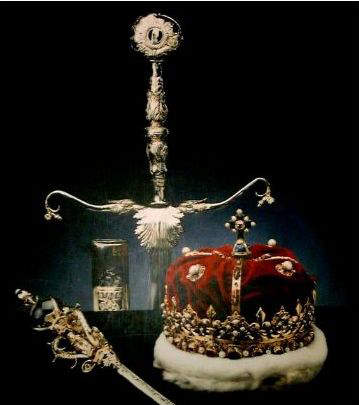
Honors of Scotland
The main features of the modern version of the Crown of Scotland
The modern version of the Crown of Scotland originated in the year 1540, when the old crown that was used by King James IV, was refashioned by the royal goldsmith, John Mosman, for King James V, who wore the crown for the coronation of his second wife, Mary of Guise, as queen consort at Holyrood Abbey, Edinburgh, in the year of its manufacture. The bonnet of velvet and ermine was added to the crown, which had two arches, on which a golden monde sat, topped off by a cross. In the remodeling more gold was added to the crown, which was mined from the Crawford Moor Mine in Scotland. In addition to the incorporation of 42 gemstones such as rubies, diamonds and amethysts, Scottish freshwater pearls taken from the old crown were also added. The weight of the crown was 3 lb. 10 oz. equivalent to 1.64 kg.
Mary, Queen of Scots - A short biography
The first time the new Crown of Scotland was used for the coronation of a Scottish monarch
King James V wore the new Crown of Scotland in 1540 for the coronation of his wife, Mary of Guise. However, the first time the new crown was used for the coronation of a Scottish monarch was in 1543, after the child monarch, Mary, Queen of Scots, the only surviving legitimate child of King James V, ascended the throne of Scotland, after the death of her father on December 14, 1542. Mary was just six days old when her father died. Her mother, Mary of Guise was appointed as regent, and Mary was crowned nine months later, on September 9, 1543. Mary married Francis, the Dauphin of France in 1558, and when Francis ascended the throne of France as Francis II in July 1559, after the death of his father Henry II, she became the Queen Consort of France. Mary held the dual title of Queen of Scots and the Queen Consort of France only for a short period, until the death of her husband in December 1560 of an ear infection.

Mary, Queen of Scots
Mary, Queen of Scots, forced to abdicate in favor of her son James VI, after 24 years on the throne
After the death of her husband she returned to Scotland in August 1561, and assumed her responsibilities as the Queen of Scotland. Four years later she remarried, taking her first cousin Henry Stuart also known as Lord Darnley as her second husband, by whom she had a son James, born on June 19, 1566. However, her second marriage ran into problems and in February 1567, Darnley was found dead in the garden at Kirk o'Field, after a huge explosion in the house. Not long afterwards she married James Hepburn, the 4th Earl of Bothwell, who was generally believed to be Lord Darnley's murderer. This led to an uprising against her, and she was imprisoned in Loch Leven Castle, and forced to abdicate in favor of her one-year-old son James on July 24, 1567. Mary made an unsuccessful attempt to regain her throne in 1568, and then escaped to England, seeking protection from Queen Elizabeth I, her father's first cousin. Elizabeth instead of providing protection, placed her under arrest, as she felt her position insecure, because Mary was considered by many to be the legitimate heir to the British crown after the death of Mary I (Mary Tudor) of England in 1558. Mary was placed under confinement in Sheffield Castle for eighteen years, and finally put on trial for treason for alleged involvement in three plots to assassinate Elizabeth, and take over the English throne; and executed by beheading on February 8, 1587, aged 44 years.

Queen Elizabeth I of England- Armada Portrait
James VI & I, "King of Great Britain" - A short biography
The new Crown of Scotland used for the second time for the coronation of a child monarch
James VI was the only son of Mary, Queen of Scotts, and ascended the throne on July 24, 1567, when he was just one year old, after his mother was imprisoned and forced to abdicate in his favor. One month later James was formally crowned as King James VI of Scotland, and the modern version of the Crown of Scotland was used again for his coronation. The boy grew up under the care of different regents, who ruled on his behalf. The boy's education was supervised by the historian and poet George Buchanan, who instilled in him a lifelong passion for literature and learning. The boy eventually turned out to be one of the most educated and enlightened monarchs in the history of Britain with several works to his credit such as "Daemonologie," "True Law of Free Monarchies," and "Basilikon Doron," Coincidentally, the period of his rule also produced literary legends such as William Shakespeare, Sir Francis Bacon, Ben Johnson and John Donne.
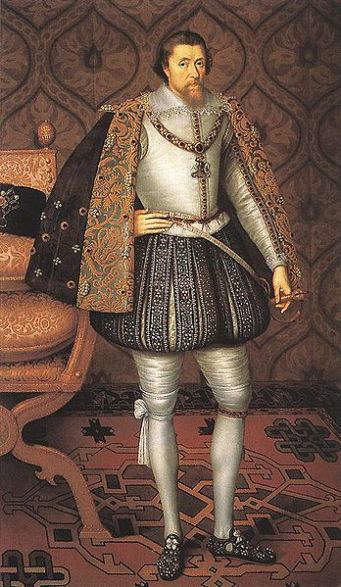
King James I (of England) and VI (of Scotland).
The Union of the Crowns, James VI succeeds Queen Elizabeth I in 1603, as the King of England and Ireland
James VI, assumed full control of his government in 1581, and on March 24, 1603, succeeded the last Tudor monarch of England and Ireland, Queen Elizabeth I, who died without issue, as King James I of England, Ireland and Scotland, and ruled for 22 years, until his death in 1625, at the age of 58. King James I, married Princess Anne of Denmark in August 1589, by whom he had three surviving children, and his second surviving child Charles I, became his successor. James' greatest ambition was to build on the personal union of the crowns of Scotland and England achieved after his ascension to the throne of England, and to establish a permanent union of the crowns, under one monarch, one parliament and one law, a plan that was opposed in both countries. The House of Commons refused to grant him the title "King of Great Britain" which he later assumed by proclamation. James achieved great successes in foreign policy and international trade. He brought the long Armada war with Spain to an end, and expanded the activities of the British East India Company and established trade contacts with Japan. James' belief in the divine right of kings as propounded in the absolute theory of monarchy set out in his book "The True Law of Free Monarchies" always brought him into constant conflict with Parliament, which he considered subservient to the monarchy. These conflicts persisted throughout his reign and well into the reign of his successor King Charles I, that precipitated the civil war culminating in the execution of Charles I. One of his greatest legacies is the standard version of the bible known as the King James Version, published in 1608, and still in widespread use among protestants.
King Charles I
His early life, marriage and coronation
King Charles I was the second son of King James VI & I and Anne of Denmark, and succeeded his father on his death on March 27, 1625, at the age of 25 years. Charles came under the influence of his father's favorite George Villiers, the Ist Duke of Buckingham, from the time he became the Prince of Wales until the death of Buckingham in 1628, just three years after he ascended the throne. Buckingham had a great influence on both Charles' personal life as well as during his initial years of rule, until his assassination in 1628. After earlier attempts by Charles to marry Infanta Maria Anna of Spain, before he ascended the throne of England, failed, due to unacceptable conditions laid down by King Philip III of Spain, he married Henrietta Maria of France, a Roman Catholic on May 11, 1625, for which parliamentary approval had been granted during the time of his father James I. The coronation of Charles I was held on February 2, 1626, at Westminster Abbey, but his Scottish coronation was held much later in 1633 at Holyrood House Abbey in Edinburgh.

King Charles I of England, Ireland and Scotland
Charles Ist's firm belief in Royal Absolutism and the Divine Right of Kings
Charles I was a firm believer in "Royal Absolutism" and the "Divine Right of Kings" as propounded by his father James I, in his book "The True Law of Free Monarchies." According to this theory as stated in his book, "Kings arose before any estates or ranks of men, before any parliaments were holden, or laws made, and by them was the land distributed which at first was wholly theirs. And so it follows of necessity that king were the authors and makers of the laws, and not the laws of the kings."
According to this theory a king may impose new laws by royal prerogative, but must also pay heed to tradition and God, who would stir up such scourges as pleaseth him, for punishment of wicked kings. In his Basilikon Doron, which was a practical guide to kingship written for the benefit of his heirs, he states, "Hold no parliaments, but for the necessity of new laws, which would be but seldom."
The difference between James Ist's and Charles Ist's style of rule
Both James I and Charles I, tried to uphold the "Divine Right of Kings" during their period of rule, but the difference was, while James I was prepared to listen to the views of his subjects, and favored compromise and consensus, Charles I was very stubborn and adamant and always stood firmly by his decisions, as he believed there was no need to compromise or even explain his rules as he was only answerable to God. His line of thinking was explicit in his well known saying "Kings are not bound to give an account of their actions but to God alone."
Charles Ist's personal rule without parliament for 11 years
Thus Charles I right from the onset of his rule was set on a confrontational course with his parliament each trying to limit the powers of the other, and parliament not approving sufficient funds for Charles to prosecute his war efforts against Spain. During the course of his rule Charles dismissed and reconvened parliament as he pleased and imposed taxes on the people by royal prerogative without the consent of the parliament. Things came to a head in 1629, when Charles decided to dispense with parliament completely and made peace with his enemies Spain and France. Charles felt that he could rule without parliament as long as he avoided war. For a period of 11 years from 1629 to 1640 he ruled without parliament, a period that came to be known as "personal rule" or "Eleven Years' Tyranny." Personal rule would have continued indefinitely during his period of rule had it not been for the Scottish invasion of England precipitated by Charles' attempt to reform the Presbyterian Church in Scotland to bring it in line with the Anglican Church.
Charles reconvenes parliament in 1640, but confrontation between the two sides increase
Charles summoned parliament again to seek funds to subdue the Scots, which was granted, but the wars that resulted known as the Bishop's Wars resulted in humiliating defeats for the king. Confrontation between the king and the parliament increased in spite of the fact that Charles granted many concessions to parliament, and Charles was forced to make peace with the Scots in order to increase support for his anti-parliamentary stand.
Charles I leaves London and sets up court in Oxford. Both sides arm themselves and civil war breaks out in 1642
The continued confrontation led to breakdown in government in England, and Charles not feeling safe in London moved towards the north of England and began raising an army against the parliament, and sent his Queen Henrietta Maria abroad to raise money for his war efforts. Both sides continued to arm themselves and Charles I set up his court in Oxford. Civil war broke out on October 26, 1642, and continued into 1643 and 1644, until the Battle of Naseby tipped the military balance in favor of the parliamentary forces led by Oliver Cromwell. Charles escaped to Scotland and sought refuge with the Scottish Presbyterian army at Newark, who in turn delivered Charles to the parliamentary forces after arriving at an agreement.
Charles is imprisoned by the parliamentary forces, but later taken into the custody of a section of the New Model Army, who persuade him to go to Isle of Wight
Charles was imprisoned at Holdenby House in Northamptonshire, but later taken into the safe custody of a breakaway group of the New Model Army led by George Joyce, and moved to Hampton Court. Charles was persuaded to go into exile to a foreign country like France, or move to Isle of Wight, to the custody of Colonel Robert Hammond. He chose the latter believing Hammond to be sympathetic towards his cause, but it turned out that he was opposed to him, and he confined Charles to Carisbrooke Castle.
Charles makes a second unsuccessful attempt to recapture his throne with Scottish help
Charles try to bargain with different sections while at Carisbrooke, and finally came to an agreement with the Scottish Presbyterians to help him regain his throne in return for in return for establishment of Presbyterianism in England and Scotland for a trial period. Accordingly the Royalists forces again rose up in July 1648, starting the second civil war, and the Scots invaded England. Pitched battles were fought by the parliamentary forces in many places to put down the uprisings, that also involved prolonged seiges. Finally with the defeat of the Scots at the battle of Preston, the odds were tilted against the royalists in winning the war.
The civil war comes to an end and Charles I is put on trial for high treason, found guilty and executed
The civil war came to an end and the victorious parliamentary forces led by Oliver Cromwell ordered that Charles be moved at the end of 1648 to Hurst Castle, and thereafter to Windsor Castle. In January 1649, the House of Commons passed an act of parliament creating a court to try Charles for treason. A High Court of Justice was set up consisting of 135 commissioners, and the Solicitor General led the prosecution. Charles was charged for high treason and other crimes, and his trial began on January 20, 1649. Charles refused to enter a plea, claiming that no court had jurisdiction over a monarch. His contention was that his authority to rule came directly from God, and by the laws and traditions of England when he was crowned and anointed, and that the power wielded by those trying him was derived from the barrel of a gun. The trial went ahead despite his objections, and Charles was found guilty of the charge of treason. Fifty nine of the commissioners signed Charles' death warrant, on January 29, 1649. After the ruling, he was moved to the Palace of Whitehall, where the execution was to take place the next day. Finally, on Tuesday January 30, 1649, Charles I was executed by beheading. His famous last words were, "I shall go from a corruptible to an incorruptible crown, where no disturbance can be."
Oliver Cromwell destroys all symbols of the ousted monarchy
After the execution of the king, the parliamentarians declared a republic, known as the commonwealth of England. During this period while the parliament exercised both executive and legislative powers, a smaller Council of State was appointed which also exercised executive functions. Oliver Cromwell was appointed a member of this council.
Oliver Cromwell ordered the melting down and dispersal of all the crown jewels of England, the powerful symbols of the monarchy, that had been used in the coronation of kings since time immemorial, so that no future monarch would be able to make use of them. Little did he know that destroying symbols may have only a marginal effect on a society which had been ruled by monarchs for thousands of years. The destruction of the crown jewels of England by Oliver Cromwell, did not prevent the restoration of the monarchy, not long after his death, under the supervision of the very same army, that eliminated the monarchy in the first place.
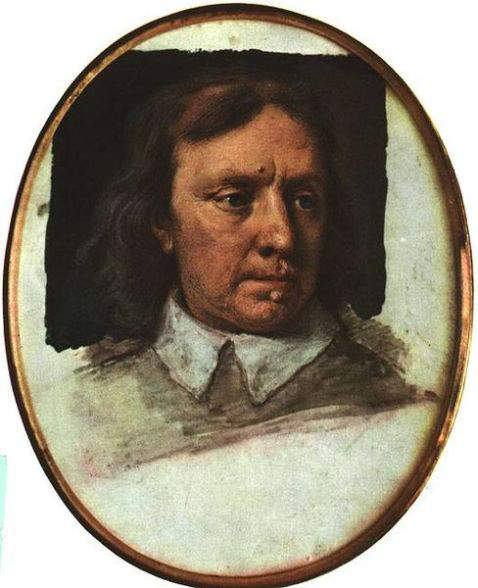
Oliver Cromwell- Member of Parliament
Cromwell invades and subdues the Irish
While the parliamentarians were busy in England trying to work out a viable alternative to the monarchy it had just eliminated, the royalists had regrouped in Ireland and Scotland. Cromwell was chosen by parliament to lead a campaign to crush the royalists and their allies, the Irish Confederate Catholics in Ireland. Cromwell's forces invaded Ireland in 1649 and within nine months was able to capture most of the eastern and northern parts of the country, after several bloody massacres. In the midst of his Ireland campaign, news reached Cromwell that Charles II, the son of the executed king had landed in Scotland and had been proclaimed king. Handing over the command of his Irish campaign to Henry Ireton and Edmund Ludlow, Cromwell returned to England on May 26, 1650, to tackle the new situation.
Cromwell invades and occupies Scotland
Cromwell then turned his attention towards Scotland, and before sending in his troops appealed to the Scottish Presbyterians, his former allies in the first English civil war, to reconsider their position in aligning themselves with the royalists. His appeal rejected Cromwell invaded Scotland, and after some initial set backs, had the war going in his favor, and at the Battle of Dunbar, killed 4,000 Scottish soldiers, took 10,000 prisoners, and captured the capital city of Edinburgh. While Cromwell was engaged in Scotland, in the following year Charles II and his allies invaded England, with a view of capturing London, and Cromwell and his forces pursued them moving southwards, and a battle ensued at Worcester in September 1651, in which the last major Scottish royalist army was decimated, and most of the prisoners-of-war taken either died of disease or sent to penal colonies in Barbados. After the conquest Scotland came under the direct rule of the commonwealth from England, and was kept under military occupation by the forces of the commonwealth until 1660.
The coronation of Charles II and the transfer of the crown jewels of Scotland to Dunnottar Castle
Immediately after the execution of Charles I on January 30, 1649, the Scottish Parliament met on February 5, 1649 in Edinburgh and proclaimed Charles II, the son of Charels I as the King of Scots. However, he was crowned King of Scots only after he landed in Scotland, and the coronation took place in Scone on January 1, 1651. This was the last time the Crown of Scotland and the other components of the "Scottish honors" used in the coronation of a king in Scotland. While the coronation of Charles was taking place in Scone, the capital city Edinburgh had already fallen to Cromwell's forces, and it was not possible to return the "Honors of Scotland" to Edinburgh Castle, from where it was taken to Scone. Cromwell's army was now fast advancing on Scone, and Charles II fearing that the same fate might befall the "Honors of Scotland," as the English Crown Jewels already destroyed by Cromwell, ordered the Earl Marischal to move the "Honors" and his personal papers to the safety of Dunnottar Castle, the home of the Earls of Marischal. The duty of the Earl of Marischal was to oversee the ceremonial activities in the Scottish Court, that included coronations.
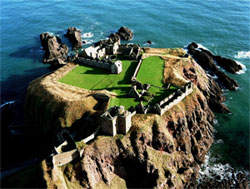
Dunnottar Castle
Cromwell's troops besiege Dunnottar Castle, but the "Honors of Scotland" are smuggled out of the castle and buried under the floor of a church
Dunnottar Castle was defended by a small garrison of 70 men, and Cromwell's forces learning that the "Honors of Scotland" had been moved to the castle besieged it, but the 70 men defending the castle were able to hold out for eight months against the invading forces. However, it soon became evident that fall of the castle was imminent, and something had to be done to save the "Honors of Scotland." The crown jewels that included the crown, scepter and sword, were bundled and lowered over the seaward side of the castle, where a serving woman under the pretext of collecting seaweed, received the bundle, and carried it to a church at Kinneff several miles to the south and delivered it to the minister of the Church. The minister, Reverend James Grainger and his wife, wrapped the jewels securely in linen cloth, and buried them under the clay floor in an isolated area of the church. At regular intervals of about three months, they brought out the jewels in the night, to expose them to the air, in order to keep them damp-free, and preserve them from any injury. In this manner the crown jewels remained hidden for nine years throughout the period of the commonwealth, while the English troops were constantly on the look out for the hidden jewels. After the capture of the Dunnottar Castle by Cromwell's troops, the occupants of the house were rigorously interrogated but the secret of the "Honors" never revealed.
The death of Oliver Cromwell and the restoration of the monarchy
Oliver Cromwell was sworn in as the "Lord Protector" for life, of England, Ireland and Scotland under a new constitution, on December 16, 1653, an office wielding executive powers to replace the ousted monarchy. He served in this capacity for five-years until 1658, when he was struck down by an attack of malarial fever and kidney infection. Cromwell's health declined rapidly and he died at Whitehall, on Friday, September 3, 1658. Cromwell was buried after an elaborate funeral ceremony at Westminster Abbey. He was succeeded by his son Richard as "Lord Protector," but unlike his father, he had no power base either in parliament or the army, and in May 1659 the army forced him to resign, bringing an end to the protectorate. Thus the death of Cromwell precipitated a political crisis, a power vacuum for which no proper mechanism was put in place during his life time. The experiment with republican rule was a dismal failure. After the enormous suffering brought to bear on the people of England, Ireland and Scotland during the long civil war, the shedding of so much of blood of so many innocent people, and the killing of a monarch by beheading, the parliamentarians led by Oliver Cromwell were not able to produce a viable alternative to the traditional monarchy that ruled these nations over the centuries. Thus the army led by George Monck, the English governor of Scotland, was forced to restore the traditional monarchy in 1660, and invite Charles II to assume his traditional role as the king of England, Ireland and Scotland.

King Charles II of England ,Ireland and Scotland.
The "Honors of Scotland" are retrieved from the church floor and returned to Edinburgh Castle
After the restoration of the monarchy in May 1660, the "Honors of Scotland" was retrieved from its hiding place in the church at Kinneff, and returned to King Charles II, who ordered that the "Honors" be returned to the Edinburgh Castle. Charles II was officially crowned as the King of England, Ireland and Scotland, at Westminster Abbey, on April 23, 1661. While Charles II held court in London, the Scottish regalia remained in the Edinburgh Castle and was carried to the Scottish parliament whenever sittings were held, signifying the sovereign's presence and his consent to the passing of each Act.
James II, Mary II and William III, Prince of Orange
Charles II died in 1685 and was succeeded by his brother James II & VII, who after a short period of rule lasting 3 years escaped to France during the Glorious Revolution, and was succeeded by his daughter Mary II, who was declared the Queen, and his son-in-law, William III, the Prince of Orange, who jointly ruled England, Ireland and Scotland. Mary II died in 1694 of small pox, and William III continued to rule alone until his death in 1702. Mary and William had no children, and therefore Wiliam III was succeeded by Mary's sister Princess Anne, who became the Queen of England, Scotland and Ireland on March 8, 1702.
Queen Anne and the signing of the Treaty of Union, that united England and Scotland as the Kingdom of Great Britain
Queen Anne ruled for 12 years from 1702 to 1714, and her period of rule was very significant for the far-reaching changes that occurred. The first such change was the signing of the Treaty of Union that took effect on May 1, 1707, and the passing of two parliamentary acts in the English and Scottish parliaments, known as the "Acts of Union," to put into effect the terms of the treaty, under which England and Scotland were to unite as a single sovereign state, known as the Kingdom of Great Britain, ruled by a single monarch, and with a single parliament, an idea that was first mooted by King James I & VI of England, Ireland and Scotland, in 1606, but rejected by both parliaments. Queen Anne earned the rare distinction of becoming the first sovereign of the Kingdom of Great Britain, while holding the separate crown of Queen of Ireland. The second far-reaching change that occurred during the end of her rule was her own succession. Queen Anne became the last of the monarchs of the House of Stuart, as she had no surviving children, and her relatives if any being Roman Catholics were excluded from power. Thus the death of Queen Anne in 1714, marked the end of a dynasty, the House of Stuart and the beginning of a new ruling dynasty the "House of Hanover," whose first king was King George I, who still was a descendant of the Stuarts through King James I & VI.
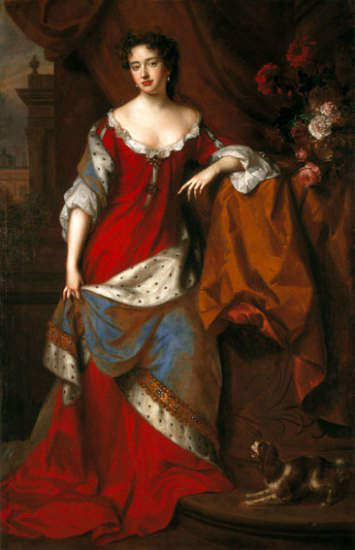
Queen Anne of Great Britain
The Scottish Crown Jewels are forgotten for over a century and rediscovered in 1818 by Sir Walter Scott
The Crown Jewels of Scotland are locked up in a chest at Edinburgh Castle in 1707
The signing of the "Treaty of Union" eliminated the Kingdom of Scotland as well as its parliament, and therefore the Crown Jewels of Scotland also known as the "Honors of Scotland" became redundant with no apparent function in the foreseeable future. The Crown Jewels were then wrapped up in linen cloth and locked away in a chest in a little strong room at Edinburgh Castle known as the crown room, on May 1, 1707, and totally forgotten for the next 111 years.
The Crown Jewels are rediscovered by Sir Walter Scott in Edinburgh Castle in 1818
Then in the year 1818, due to the effort of one motivated individual, Sir Walter Scott, the prolific Scottish historical novelist and poet, whose novels based on Scottish historical settings projected Scottish history in a new romantic light, the Scottish Crown Jewels were rediscovered, and put on display at the Edinburgh Castle. In the year 1814, Sir Walter Scott published his first historical novel "Waverley" a tale of the 1745 Jacobite uprising in the Kingdom of Great Britain, with its English protagonist Edward Waverley, by his Tory upbringing sympathetic to Jacobitism, becoming enmeshed in events, but eventually choosing Hanoverian respectability. In "Waverly" the identity of the author of the novel was withheld, and the novel achieved considerable success. Then followed a succession of novels under the pseudonym "Author of Waverly" each with a Scottish historical setting. Eventually the mysterious best-selling author was given the nickname "The Wizard of the North."
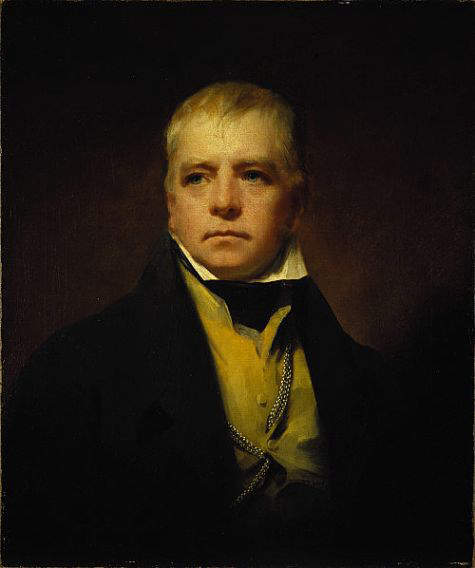
Sir Walter Scott
The anonymous author became so popular, that one of his admirers was none other than the Prince Regent, George (later King George IV), who was very anxious to meet the "Author of Waverly" and thus Sir Walter Scott was given the honor of dining with the Prince Regent. This gave him a rare opportunity to build up a close relationship with the Prince Regent, which he subsequently used in seeking permission from the Prince, to search the Edinburgh Castle including the crown room for the Royal Scottish Regalia, which was granted in 1818. Sir Walter Scott was present when the crown room was opened, and the dust-covered oak chest was located in a corner of the room. The searchers then opened the chest, and to the great relief and joy of Sir Walter Scott, the regalia were discovered at the bottom of the chest wrapped in linen cloth exactly as they had been left after the union, 111 years ago. The news of the discovery was conveyed to the Prince Regent, who too expressed his happiness over the discovery. The regalia that consisted of the Scottish Crown, the Scepter and the Sword, the oldest surviving crown jewels in the history of Great Britain, was then cleaned, and put on display in the same crown room of Edinburgh Castle, on February 4, 1818, where it had been on public display ever since.
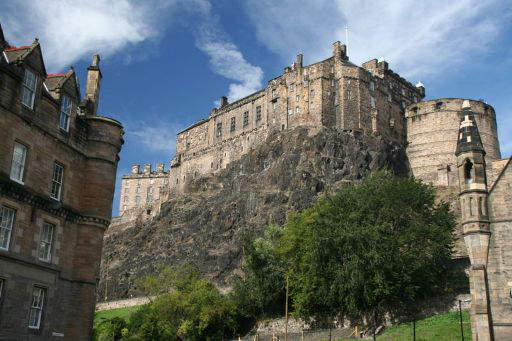
Edinburgh Castle
The Crown of Scotland again resumes its ceremonial role
In 1822 King George IV visited Scotland, the first by a reigning British Monarch since 1651, and the Honors of Scotland were presented to the king, at the Palace of Hollyroodhouse. Again on June 24, 1953, after the coronation of Queen Elizabeth II at Westminster Abbey, the Honors of Scotland including the crown, was taken in procession from the Palace of Hollyroodhouse, to the High Kirk of St. Giles, Edinburgh, where they were presented to the Queen, during a National Service of Thanksgiving. The Crown of Scotland has again partially resumed its former ceremonial role, and was used in the opening ceremonies of the new Scottish parliament sessions, including the first meeting of the modern parliament in 1999, and as recently as 2004, at the official opening of the new Scottish Parliament Building.
You are welcome to discuss this post/related topics with Dr Shihaan and other experts from around the world in our FORUMS (forums.internetstones.com)
Related :-
3) Paterson Pearl or Queen Pearl
References :-
1) Scottish National Heritage - Press Releases, Crime Staff, Bailiffs, and SNH in fight against criminals. www.snh.org.uk
2) Uncertain Future for Scotlands River Gem - SNH Magazine, 2008
3) The Earl of Kelly - From Wikipedia, the free encyclopedia
4) Clan Kelly - From Wikipedia, the free encyclopedia
5) Mary I of Scotland - From Wikipedia, the free encyclopedia
6) James I of England - From Wikipedia, the free encyclopedia
7) List of Provosts and Lord Provosts of Aberdeen - From Wikipedia, the free encyclopedia
8) The Treaty of Union - From Wikipedia, the free encyclopedia
9) Acts of Union 1707 - From Wikipedia, the free encyclopedia
10) Charles I of England - From Wikipeia, the free encyclopedia
11) Charles II of England - From Wikipedia, the free encyclopedia
12) English Restoration - From Wikipedia, the free encyclopedia
13) Oliver Cromwell - From Wikipedia, the free encylopedia
14) Sir Walter Scott - From Wikipedia, the free encyclopedia.
15) Honors of Scotland - From Wikipedia, the free encyclopedia
16) Crown of Scotland - From Wikipedia, the free encyclopedia
Powered by Ultra Secure
Amazon (USA) Cloud Network

Founder Internet Stones.COM
Register in our Forums
| Featured In
|
|
|
|
|
|
|
|


















